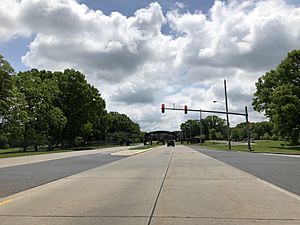New Hanover Township, New Jersey facts for kids
Quick facts for kids
New Hanover Township, New Jersey
|
|
|---|---|
|
Township
|
|

Cookstown, an unincorporated community within New Hanover Township
|
|

New Hanover Township highlighted in Burlington County. Inset map: Burlington County highlighted in the State of New Jersey.
|
|
| Country | |
| State | |
| County | |
| Royal charter | December 2, 1723 |
| Incorporated | February 21, 1798 |
| Government | |
| • Type | Township |
| • Body | Township Committee |
| Area | |
| • Total | 22.56 sq mi (58.42 km2) |
| • Land | 22.33 sq mi (57.84 km2) |
| • Water | 0.22 sq mi (0.58 km2) 0.99% |
| Area rank | 122nd of 565 in state 11th of 40 in county |
| Elevation | 105 ft (32 m) |
| Population
(2020)
|
|
| • Total | 6,367 |
| • Estimate
(2023)
|
6,348 |
| • Rank | 333rd of 565 in state 26th of 40 in county |
| • Density | 285.1/sq mi (110.1/km2) |
| • Density rank | 480th of 565 in state 33rd of 40 in county |
| Time zone | UTC−05:00 (Eastern (EST)) |
| • Summer (DST) | UTC−04:00 (Eastern (EDT)) |
| ZIP Code |
08511 – Cookstown
|
| Area code(s) | 609 |
| FIPS code | 3400551510 |
| GNIS feature ID | 0882088 |
| Website | |
New Hanover Township is a community located in Burlington County, in the state of New Jersey. It is part of a larger area that includes Philadelphia, Reading, and Camden. In 2020, about 6,367 people lived here.
Contents
History of New Hanover Township
New Hanover Township has a long history! It was first created by a special document called a Royal charter on December 2, 1723. This means it was officially recognized as a place.
Later, on February 21, 1798, it became one of New Jersey's first 104 townships. Over time, some parts of New Hanover Township became their own separate towns. These include Pemberton borough in 1826, Pemberton Township in 1846, North Hanover Township in 1905, and Wrightstown in 1918.
Geography and Local Areas
New Hanover Township covers about 22.56 square miles (58.42 square kilometers). Most of this area is land, with a small amount of water.
Important Communities
Two important places in the township are Fort Dix and McGuire Air Force Base. These are large military areas.
Cookstown is a small community located close to Fort Dix. Other small places and areas within the township include Cranberry Hall, Fountain Green, and Pointville.
Neighboring Towns
New Hanover Township shares its borders with several other towns. In Burlington County, it borders North Hanover Township, Pemberton Township, and Wrightstown. It also borders Plumsted Township in Ocean County.
The Pinelands National Reserve
A special part of New Hanover Township is located within the New Jersey Pinelands National Reserve. This is a huge protected natural area with unique plants and animals. It covers over 1.1 million acres and is recognized as a United States Biosphere Reserve. It was set up by Congress in 1978 to protect its special environment.
Education in New Hanover Township
Students in New Hanover Township attend different schools depending on where they live.
Local Public Schools
Most students from pre-kindergarten through eighth grade go to the New Hanover Township School. This school serves children from both New Hanover Township and Wrightstown.
Students who live on the military base (Joint Base McGuire-Dix-Lakehurst) have different school options. They do not attend the New Hanover schools.
High School Education
For high school, students from New Hanover Township (outside the military area) and Wrightstown attend Bordentown Regional High School. This high school is part of the Bordentown Regional School District.
Vocational and Technical Schools
Students from New Hanover Township, like all students in Burlington County, can also choose to attend the Burlington County Institute of Technology. This school offers special training for jobs and technical skills. It has campuses in Medford and Westampton Township.
Transportation
Getting around New Hanover Township is possible by road and public bus.
Roads and Highways
The township has about 24 miles of roads. Some are maintained by the local government, some by Burlington County, and a small part by the state of New Jersey.
New Jersey Route 68 ends in New Hanover Township. Part of County Route 545 is not accessible because it goes through a restricted area on Fort Dix.
Public Bus Service
NJ Transit provides bus service in the township. The 317 bus route connects New Hanover Township to places like Asbury Park and Philadelphia.
Notable People
People who have lived in or are connected to New Hanover Township include:
- Edward Settle Godfrey (1843–1932): He was a United States Army Brigadier General. He received the Medal of Honor for his brave leadership during the Indian Wars.
See also
 In Spanish: Municipio de New Hanover (Nueva Jersey) para niños
In Spanish: Municipio de New Hanover (Nueva Jersey) para niños





